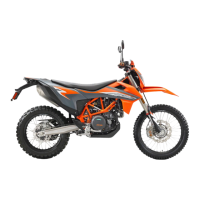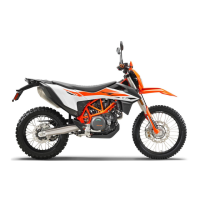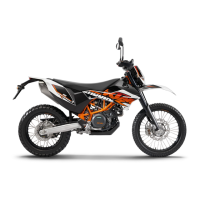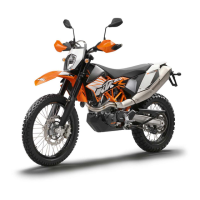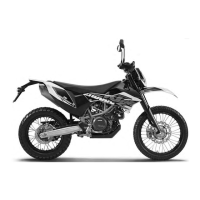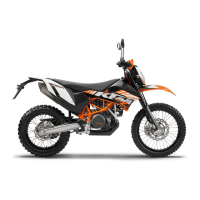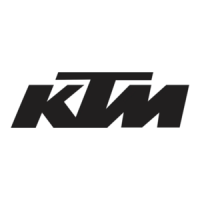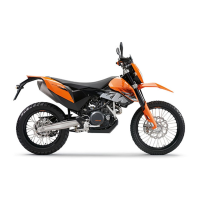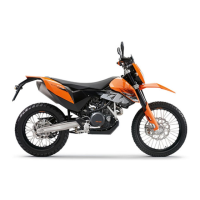
Do you have a question about the KTM 690 Enduro R EU and is the answer not in the manual?
| Displacement | 692.7 cm³ |
|---|---|
| Bore x Stroke | 105 mm x 80 mm |
| Compression Ratio | 12.7:1 |
| Starter | Electric starter |
| Transmission | 6-speed |
| Cooling | Liquid cooled |
| Lubrication | Forced oil lubrication with 2 oil pumps |
| Primary Drive | 36:79 |
| Clutch | APTC slipper clutch, hydraulically actuated |
| Frame | Chromium-Molybdenum steel trellis frame, powder coated |
| Subframe | Aluminum |
| Front Suspension | WP XPLOR-USD, Ø 48 mm |
| Rear Suspension | WP XPLOR with Pro-Lever linkage |
| Suspension Travel Front | 250 mm |
| Suspension Travel Rear | 250 mm |
| ABS | Bosch 9.1 MP (incl. Cornering-ABS and offroad mode, disengageable) |
| Wheels Front | 1.85 x 21" |
| Wheels Rear | 2.50 x 18" |
| Tires Front | 90/90-21 |
| Tires Rear | 140/80-18 |
| Chain | X-Ring 5/8 x 1/4" |
| Steering Head Angle | 63.5° |
| Seat Height | 910 mm |
| Fuel Capacity | 13.5 l |
| Dry Weight | 146 kg |
| Engine Type | Single cylinder, 4-stroke engine |
| Power | 55 kW (74 hp) |
| Torque | 73.5 Nm |
| Handlebar | Aluminum, tapered |
| Front Brake | brake disc Ø 300 mm |
| Rear Brake | Brembo single-piston floating caliper, brake disc |
| Wheelbase | 1504 mm |
Explains symbols and typographical conventions used throughout the manual for clarity and consistency.
Defines motorcycle usage and stresses maintenance compliance for optimal performance and longevity.
Covers warranty conditions, recommendations for spare parts, and general work rules.
Addresses environmental responsibility, notes/warnings, and defines risk levels (Danger, Warning, Caution, Note).
Identifies major motorcycle components visible from the front left side.
Identifies major motorcycle components visible from the rear right side.
Locates the chassis number, type label, and engine number for vehicle identification.
Provides information on finding the key number and locating fork/shock absorber part numbers.
Details operation of clutch, brake levers, throttle grip, light switch, turn signals, and horn.
Explains the function of emergency OFF, starter button, and ignition/steering lock.
Covers instrument cluster overview, buttons, indicator lamps, display, and trip meters.
Explains the fuel reserve warning (TRIP F) and coolant temperature indicators.
Instructions for fuel cap, seat release, handrails, footrests, and levers.
Details the function and safety aspects of the side stand.
Crucial safety guidelines for initial operation, including protective gear and tire conditions.
Procedures for running in the engine and safe loading practices to maintain handling.
Essential checks before riding to ensure vehicle safety and roadworthiness.
Steps for starting the engine and beginning to ride, including safety precautions.
Proper braking methods, conditions affecting efficiency, and system failure warnings.
Procedures for stopping, parking securely, and safe refueling practices.
Schedule of required maintenance tasks at different mileage/time intervals.
Guidance on adjusting fork and shock absorber damping for performance.
Procedures for measuring and adjusting static and riding sag for optimal setup.
Options and procedures for adjusting handlebar mounting position for rider comfort.
Safe methods for raising the motorcycle with a lift stand and securing it.
Bleeding fork legs, cleaning dust boots, and checking/adjusting steering head bearings.
Steps for removing and installing the seat and air filter for maintenance.
Checking and cleaning the drive chain, including tension adjustment.
Adjusting clutch lever position and checking hydraulic clutch fluid level.
Checking front brake lever travel, discs, fluid level, and linings.
Checking rear brake lever travel, fluid level, and linings.
Procedures for removing and installing the front and rear wheels.
Checking hub dampers, bearings, tire condition, and air pressure.
Method for checking and correcting spoke tension for wheel integrity.
Procedures for removing, installing, and recharging the battery.
How to change the main fuse and fuses for individual power consumers.
Removing/installing headlight assembly, changing bulbs, and adjusting aim.
Basic operation of the cooling system and checking antifreeze/coolant levels.
Procedures for draining and refilling the cooling system with coolant.
Checking and adjusting the play in the throttle cable for optimal response.
Instructions for selecting different engine performance maps based on fuel quality.
Procedure for checking engine oil level and changing oil and filter.
Steps for removing the oil filter and cleaning the oil screens.
How to add the correct amount and type of engine oil.
Guidelines for cleaning the motorcycle, avoiding high pressure and direct sun.
Measures to protect the motorcycle from road salt and corrosion during winter.
Steps for preparing the motorcycle for extended storage, including fluid and battery care.
Procedures for preparing the motorcycle after a period of storage.
Diagnosing and resolving common engine starting and running problems.
Troubleshooting low power, overheating, and warning lamp indicators.
Resolving problems with fuses, battery, display, and speedometer functions.
Interpreting fault codes indicated by the FI warning lamp flashes.
Key engine data including displacement, bore, coolant, and oil capacities.
Torque values for engine component fasteners.
Data on frame, suspension, brakes, tire sizes, and capacities.
Specifications for lighting equipment and chassis component fasteners.
Details on fork and shock absorber damping, springs, and oil.
Approved brake fluids, coolants, oils, and auxiliary substance recommendations.
Explanations of automotive oil standards like JASO and SAE.

